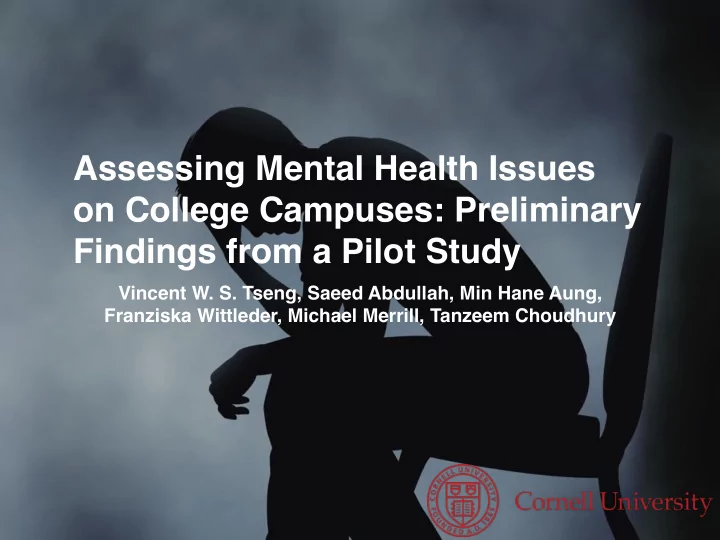

Assessing Mental Health Issues on College Campuses: Preliminary Findings from a Pilot Study Vincent W. S. Tseng, Saeed Abdullah, Min Hane Aung, Franziska Wittleder, Michael Merrill, Tanzeem Choudhury
1 in 5 adults in the U.S. has mental illness in a year 2
1 in 5 adults in the U.S. has mental illness in a year 1 in 4 college students in the U.S. has mental illness in a year 3
Based on 19,681 students over 40 schools, • 80% felt overwhelmed by their responsibilities. 4
Based on 19,681 students over 40 schools, • 80% felt overwhelmed by their responsibilities. • 35% felt difficult to function due to depression. 5
Based on 19,681 students over 40 schools, • 80% felt overwhelmed by their responsibilities. • 35% felt difficult to function due to depression. • 10% considered suicide at least once. 6
Based on 19,681 students over 40 schools, • 80% felt overwhelmed by their responsibilities. • 35% felt difficult to function due to depression. • 10% considered suicide at least once. However, 40% of them did not seek help. 7
Barriers to Accessing Support 40 36 34 30 25 24 % 20 16 15 10 0 Stigma Busy Schedule Hours of Lack Long Wait Other Services Information Reasons 8
Appointment Wait Times 40 39 30 23 % 20 20 18 10 0 ≥ 5 Days 2~4 Days 1~2 Days 1 Day Days to wait 9
Ratio of student to psychological counselors is 1900 : 1 10
A new tool to monitor students’ behavior and assess their mental well-being continuously and unobtrusively is needed.
86% of US college student regularly use a smartphone.
Pilot Study - Smartphone Based Mental Health Assessment Tool • Conducted in an Ubicomp class in the Spring term (4 months) at Cornell University. • Cornell health center was involved. • 22 participants (12 females and 10 males) participated. 13
Pilot Study - Smartphone Based Mental Health Assessment Tool • App was run on iOS and Android devices. • Both self-assessment survey and passive sensing data were collected. 14
Sensor Survey Data Data Well-being Sleep Photographic Affect Meter Survey Survey (PAM) Survey Beginning,midterm, 10:30 AM 10:30 AM end of semester 4:30 PM 15
Sensor Survey Data Data Photographic Affect Meter (PAM) Survey 16
Sensor Survey Data Data Activity Call Location Charging Audio 17
Survey Data - Sleep Duration Over Weekdays and Weekends 18
Survey Data - Sleep Duration During Study and Exam Period 19
Survey Data - Average Stress Level Over the Semester 20
The low-dimension structures of students’ sensor data might be indicative of the underlying pattern of their daily behavior. 21
Robust PCA - Method for Recovering Corrupted Low-Rank Matrices Given high-dimension data D , decompose D into A and E . where D = A + E . Low-rank component Sparse component (gross errors) Zhouchen Lin, Minming Chen, and Yi Ma. 2010. The augmented lagrange multiplier method for exact recovery of corrupted low-rank matrices. arXiv preprint arXiv:1009.5055 (2010). 22
Robust PCA - Method for Recovering Corrupted Low-Rank Matrices Given high-dimension data D , decompose D into A and E . where D = A + E . Low-rank component Sparse component (gross errors) = + D Observation A Low-rank E Sparse Zhouchen Lin, Minming Chen, and Yi Ma. 2010. The augmented lagrange multiplier method for exact recovery of corrupted 23 low-rank matrices. arXiv preprint arXiv:1009.5055 (2010).
Robust PCA - Finding Underlying Behavioral Pattern Given high-dimension data D , decompose D into A and E . where D = A + E . Low-rank component Sparse component (gross errors) = + D Raw Sensor Data A Underlying Pattern E Noise 24
Example - The Raw Sensor Data from One User = + #seconds user being active during an hour Raw Activity Data 25
Example - The Low-rank Matrix from the User’s Sensor Data = + Low-rank matrix after decomposition RPCA Raw Activity Data Underlying Activity Pattern 26
Example - The Low-rank Matrix from the User’s Sensor Data = + Sleep 27
Example - The Low-rank Matrix from the User’s Sensor Data = + Class Class 28
Example - The Low-rank matrix from the User’s Sensor Data = + February Spring Break Break 29
Next Step - Identifying the Change of Behavioral Pattern Underlying Behavioral Pattern Activity Audio Phone Use Mental Well-Being GPA 30
Future Work - Early Intervention Help students manage their own mental welling and introduce timely mental health service from their caregivers. 31
Thank you!
Recommend
More recommend